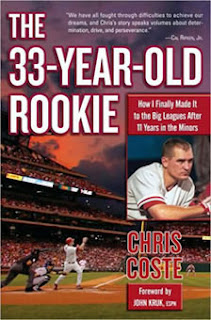With his body weakening, his age rising, and his doubts growing, Chris Coste was fighting against the odds to do what he loved. His amazing story is highlighted in his autobiography, The 33-Year-Old Rookie, and explains his ascension on the baseball hierarchy. Coste's motivation behind creating his book: spreading the story of his amazing battle to save his career and become a major league baseball player. Coste's life goes beyond simply being a good enough athlete to reach the big leagues, but a rare display of perseverance and determination, despite the dwindling his window of athletic opportunity, that can inspire anyone to follow their dreams. Coste achieves this through his connections to the past, telling tremendous recollections of his first meeting with Charlie Manual, the Phillies' manager, and his first time playing catcher. Another effective strategy Coste uses in his book is a unique structure, placing his first Major League Baseball experiences in the first chapter and then moving back to his days in elementary school to begin his life's timeline. This excites readers and helps them in keeping a result or ending point in mind throughout the book. When reading, I found myself questioning what limits there are on what I can do, disregarding the negative responses people give me when presenting ambitious goals. Coste's book is able to provoke these thoughts, with an accurate depiction of his rollercoaster-esque career and the focus on victory despite many conflicting factors. It is a book I will surely recommend to others and remember when facing strong competition or battling the giants that face my hopes and dreams.
Friday, January 18, 2013
Sunday, January 13, 2013
TOW Rewrite (From #7)
Sunday, January 6, 2013
The New Yorker Political Cartoon
Many
people question the truth in political speeches and the true intellect of the
people giving the promises. This political cartoon recently published by the
New Yorker plays on the questionable image politicians have in a large
portion of Americans. The cartoon has one main purpose: to portray the idea
that the politicians we see on television are nothing without the advisers they
receive aid from. This is scene in the dialogue between the speaker and his
female assistant, with the woman saying, “Jobs, jobs, jobs.” This caption becomes
humorous with the audience holding up their ‘JOB’ signs, making the issue of
job creation and strengthening the economy a no-brainer. This conflict in
themes makes this cartoon so effective, emphasizing the theory that politicians
are not responsible for the amount of problem solving and decision-making that
we the public give them credit for. For the New York citizens as well as
Americans across the country, the cartoon creates a newfound awareness for the
political stage and has the potential to change the way that Americans see and
evaluate their vote. David Sipress, the New Yorker cartoonist who created this
cartoon, is able to achieve his purpose of bringing about intrigue to the
office and role of politicians in the scheme of the government. This piece
creates an visual that draws on past anger towards public office and almost
forces people to laugh at the scene, showing the success of Sipress’s work.
Subscribe to:
Comments (Atom)


